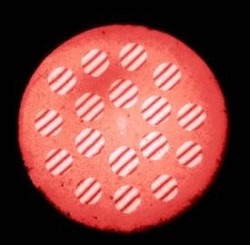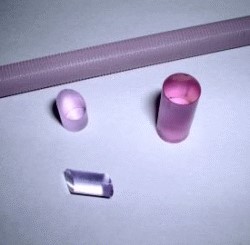Leysop employs a number of highly skilled optical polishing technicians, each with many years of experience of cutting and polishing of a varied range of materials. Using mainly hand polishing techniques for the ultimate control of surface finish and figure, optical surfaces may be routinely produced to better than λ/10 (633nm) and laser finish scratch-dig of better than 10-5.
A wide variety of substrates may be polished and Leysop technicians have experience of materials from the softest (ADP, KD*P) to some of the hardest optical materials (ruby, sapphire, germanium). In fact, the water soluble crystals present special challenges for the optical polisher (for obvious reasons)! Leysop staff however can produce the highest quality laser grade surfaces as demanded by use in high power laser systems.
Leysop offers contract cutting and polishing services to meet your individual needs. Equipment includes diamond saws, edging grinders for reducing diameters and producing discs and diamond core drilling. All of these are water free for working the specially critical water soluble crystals used in our Q-switches and modulators. These are all backed by Leysop’s team of highly skilled technicians who can produce precision optical components to your specification.

No job is too big or too small.
Although much of Leysop’s work is optical production based, much of their capacity is also available for those small jobs, perhaps manufacturing a special prism in small quantities, or re-working a laser rod which has suffered optical damage.
Lithium Tantalate (LiTaO3)
Lithium tantalate does not possess any useful r22 electro-optic coefficient and so is not used in an optic axis propagation mode. Instead, it is orientated such that light propagates down the Y axis and the electric field is across the Z-direction. Thus the r13 electro-optic coefficient which has the value of approximately 7.0 x 10-12mV-1 is used. As this is a birefringent axis, a composite pair of crystals is again used for birefringence cancellation and if well matched crystals are used the temperature stability is very good indeed (due in part to the relatively small value of birefringence).
At first glance, there would seem to be little advantage to using lithium tantalate over lithium niobate in the z-cut mode. However, lithium tantalate has practically no piezo-electric activity and so its dc and ac response are identical. One consequence of the piezo-electric activity in lithium niobate is that at certain frequencies it may be possible to set up acoustic resonances in the device when driven in a repetitively pulsed mode for example. This causes distortions in the modulation such as ringing of the optical transmission, and worse still, under hard excitation can lead to premature destruction of the crystal. This severely limits the use of lithium niobate for some applications, but no such limitations occur in lithium tantalate until very high frequencies are encountered. Also, the optical transmission range of lithum tantalate is similar to lithium niobate, but it does not suffer the short wavelength optical damage effects described earlier. This makes it particularly suited to moderately high power visible laser applications with for example argon ion and frequency doubled Nd+:YAG lasers.

Some example sizes and performances are given in the following table (remember that these values apply both to dc and ac driven applications, but dimensions refer to each crystal of the composite pair):
Dimensions (mm)
3 x 3 x 12
2.5 x 2.5 x 24
Vp(1064nm)
630 V
263 V
Vp(633nm)
350 V
146 V
Vp(458nm)
217 V
90 V
